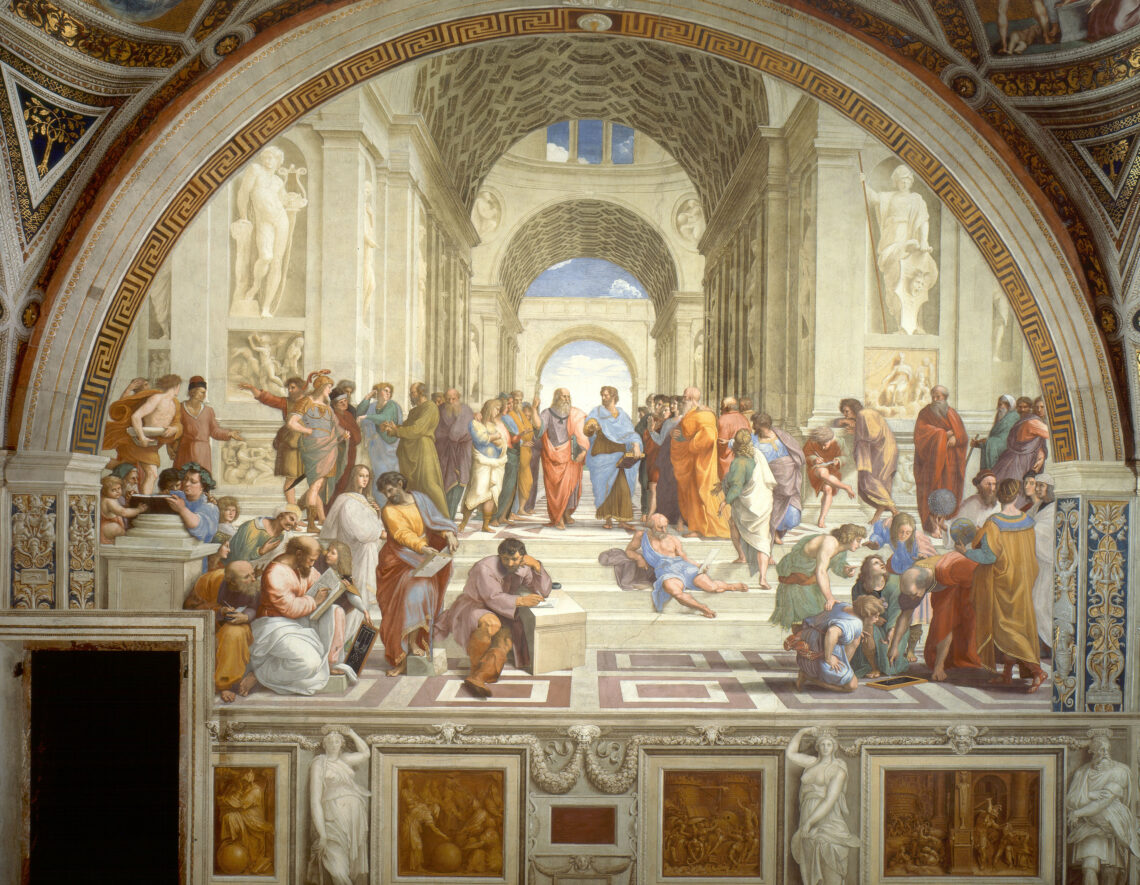The School of Athens is a fresco by renaissance artist Raffaello Sanzio (Raphael), representing the greatest intellectual figures of the time. It is one of the four frescoes commissioned by Pope Julius II, and is still on display in its original place of creation in Vatican City. The School of Athens is believed to be Raphael’s masterpiece, demonstrating the pinnacle of high renaissance art. In this article, Singulart explores the high renaissance movement and discusses the important figures portrayed in The School of Athens and why it is such a significant artwork for Raphael.
Raphael and the High Renaissance Movement

The high renaissance period of art occurred from the early 1490s to 1527, heralded by masters Raphael, Michelangelo and Leonardo da Vinci. The period marked the culmination of the advanced techniques that had been in practice in the renaissance period, such as linear perspective, realistic depiction, and specific techniques such as chiaroscuro (the creation of a contrast between dark and light) and sfumato (using a soft, hazy technique to transition between colors).
The era was also characterized by a return to humanism, and to the classic Roman and Greek philosophies regarding man’s place in the world. The artists of the high renaissance period depicted religious icons in a more humanized way, rather than the idealized religious iconography of the medieval era. Although realism was a key feature of the high renaissance period, above all the artists were looking to capture beauty on their canvases.
The high renaissance period also ushered in new techniques. Artists were using oil to paint with, typically on canvases but also using wood on occasion. The trompe l’oeil (trick of the eye) technique was also being used more frequently, as seen in The School of Athens: it almost appears as if the viewer could step directly into the scene, due to the composition and sheer size of the fresco.
Who is represented in The School of Athens?

The two central figures in The School of Athens are philosophers Plato and Aristotle. Situated under the archway and in the center of the fresco, the viewer’s eye is immediately drawn to the two men, appearing to be in an intense discussion. On the left, Plato is gesturing towards the sky, a nod to his Theory of Forms. The theory argues that our physical world is not the “real” world, with the actual real world being a spiritual realm composed of abstract thoughts and ideas.
Aristotle has his hand outstretched towards the audience, in what critics believe is a brilliant example of foreshortening: displaying an illusion of extension or dimension. Aristotle’s outstretched arm depicts his philosophy; in direct opposition to Plato, Aristotle believed that the only reality is the one we can experience through our senses of sight, sound, and touch. This theory became known as empiricism. Each is holding a copy of a text supporting their theory; Plato holds his book The Timaeus, while Aristotle holds Ethics.

To the left of the fresco, we can see mathematician Pythagoras studying a large tome. Pythagoras believed the world operated under the influence of mathematical laws. Pythagoras also believed in “the harmony of the spheres,” that each planet produced a musical note based on its movements and its distance relative to Earth. He was also a believer in metempsychosis, which states that every soul is immortal and will inhabit a new body after death. These beliefs could be the reason why Raphael has placed him to the side of Plato.
Holding a sphere on the right side of the fresco is mathematician and astronomer Ptolemy. Ptolemy had attempted to use mathematical reasoning to explain the movement of the planets. He can be seen talking to Zoroaster, an astronomer, who is holding a celestial globe in his hands. They are holding court with a group of men that interestingly also contains Raphael, in one of his only self-portraits. Raphael can be seen looking directly at the viewers, just over the left shoulder of Ptolemy.

Although it is difficult to distinguish all of the figures depicted in The School of Athens, historians generally agree that the figures of Euclid, Averroes, Epicurus, Diogenes, and Heraclitus are also portrayed. It is thought that Raphael was having a slight dig at Michelangelo by using his form to portray Heraclitus, who was thought to have been a solitary, despondent man.
The two enormous statues that stand over the scene are Apollo, god of music and arts, and Athena, goddess of wisdom and reason. Apollo stands on the left, demonstrating Plato’s beliefs, while Athena stands over Aristotle on the right.
Why is this artwork so significant?
The School of Athens is considered Raphael’s masterpiece, both as a personal feat and as a pinnacle of the high renaissance period. His combination of modern characters contrasting with philosophical figures from Ancient Greece is an embodiment of the humanism employed during the high renaissance movement.
The fresco is also lauded with praise for Raphael’s use of perspective. Raphael has used a unique one-point perspective, which means the lines of the pillars and the floor tiles converge to a single disappearing point in the background, between the heads of Plato and Aristotle. The way that the lines converge to this point also ensures that the viewer’s attention is diverted to these two figures. They may be towards the background of the painting, but through the one-point perspective and the bright, rich colors of their robes, viewers can tell that they are the focal point of the piece.
The fresco was immediately adored and revered upon its unveiling, in contrast to other high renaissance pieces such as Michelangelo’s Sistine Chapel ceiling. After his untimely death, Raphael was heralded amongst one of the greatest artists of the high renaissance period.
















